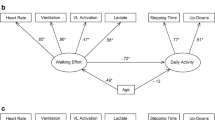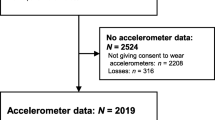Abstract
Objective
To study the effect of age on the association between body fat percentage and maximal walking speed in older people.
Design and participants
Cross-sectional analysis of data collected in the Finnish population-based Health 2000 Survey involving 916 men and 1 222 women aged 55 years and older with complete data on body composition and a walking speed test.
Methods
Body fat percentage was assessed using bioelectrical impedance analysis and maximal walking speed based on a timed walking test over a distance of 6.1 meters. Linear regression models were used to study the effect of age on association between body fat percentage and maximal walking speed.
Results
The association between body fat percentage quartiles and maximal walking speed differed significantly between persons of different ages (p for age interaction = 0.027). In the agestratified analyses, the association between body fat percentage and maximal walking speed remained significant among 60–69-year olds and 70–79-year olds, but disappeared among 55–59-year-olds and 80-year and older after adjustment for potential covariates. Body fat percentage explained 11% of the variation in maximal walking speed among 55–59-year-olds, 21% among 60–69-year-olds, 17% among 70–79-year-olds and 11% among 80-year and older.
Conclusion
Association between body fat percentage and maximal walking speed was strongest between the ages of 60 and 79 years. The results suggest that the effects of excess body fatness are especially harmful for physical functioning among adults in their sixties and seventies and they could benefit from interventions.
Similar content being viewed by others
References
Andreyeva T, Michaud PC, van Soest A. Obesity and health in Europeans aged 50 years and older. Public Health 2007;121:497–509.
Arterburn DE, Crane PK, Sullivan SD. The coming epidemic of obesity in elderly Americans. J Am Geriatr Soc 2004;52:1907–1912.
Stenholm S, Sainio P, Rantanen T, Koskinen S, Jula A, Heliövaara M, et al. High body mass index and physical impairments as predictors of walking limitation 22 years later in adult Finns. J Gerontol A Biol Sci Med Sci 2007;62:859–865.
Patterson RE, Frank LL, Kristal AR, White E. A comprehensive examination of health conditions associated with obesity in older adults. Am J Prev Med 2004;27:385–390.
Stenholm S, Rantanen T, Heliövaara M, Koskinen S. The mediating role of Creactive protein and handgrip strength between obesity and walking limitation. J Am Geriatr Soc 2008;56:462–469.
Woodrow G. Body composition analysis techniques in the aged adult: Indications and limitations. Curr Opin Clin Nutr Metab Care 2009;12:8–14.
Kyle UG, Bosaeus I, De Lorenzo AD, Deurenberg P, Elia M, Manuel Gomez J, et al. Bioelectrical impedance analysis-part II: Utilization in clinical practice. Clin Nutr 2004;23:1430–1453.
Dehghan M, Merchant AT. Is bioelectrical impedance accurate for use in large epidemiological studies? Nutr J 2008;7:26.
Visser M, Harris TB, Langlois J, Hannan MT, Roubenoff R, Felson DT, et al. Body fat and skeletal muscle mass in relation to physical disability in very old men and women of the Framingham Heart Study. J Gerontol A Biol Sci Med Sci 1998;53:M214–221.
Visser M, Langlois J, Guralnik JM, Cauley JA, Kronmal RA, Robbins J, et al. High body fatness, but not low fat-free mass, predicts disability in older men and women: The Cardiovascular Health Study. Am J Clin Nutr 1998;68:584–590.
Bouchard DR, Beliaeff S, Dionne IJ, Brochu M. Fat mass but not fat-free mass is related to physical capacity in well-functioning older individuals: Nutrition as a determinant of successful aging (NuAge) —the Quebec Longitudinal Study. Gerontol A Biol Sci Med Sci 2007;62:1382–1388.
Aromaa A, Koskinen S, editors. Health and functional capacity in Finland. Baseline results of the health 2000 health examination survey. Publications of the National Public Health Institute B12/2004. Helsinki 2004.
Heistaro S, ed. Methodology Report; Health 2000 Survey. Publications of the National Public Health Institute B26/2008. Helsinki 2008.
Kyle UG, Schutz Y, Dupertuis YM, Pichard C. Body composition interpretation. Contributions of the fat-free mass index and the body fat mass index. Nutrition 2003;19:597–604.
Gallagher D, Heymsfield SB, Heo M, Jebb SA, Murgatroyd PR, Sakamoto Y. Healthy percentage body fat ranges: An approach for developing guidelines based on body mass index. Am J Clin Nutr 2000;72:694–701.
Sainio P, Koskinen S, Heliövaara M, Martelin T, Harkanen T, Hurri H, et al. Selfreported and test-based mobility limitations in a representative sample of Finns aged 30+. Scand J Public Health 2006;34:378–386.
Burke GL, Arnold AM, Bild DE, Cushman M, Fried LP, Newman A, et al. Factors associated with healthy aging: The Cardiovascular Health Study. J Am Geriatr Soc 2001;49:254–262.
Guralnik JM, LaCroix AZ, Abbott RD, Berkman LF, Satterfield S, Evans DA, et al. Maintaining mobility in late life. I. demographic characteristics and chronic conditions. Am J Epidemiol 1993;137:845–857.
Kyle UG, Genton L, Hans D, Karsegard L, Slosman DO, Pichard C. Age-related differences in fat-free mass, skeletal muscle, body cell mass and fat mass between 18 and 94 years. Eur J Clin Nutr 2001;55:663–672.
Kyle UG, Genton L, Hans D, Karsegard VL, Michel JP, Slosman DO, et al. Total body mass, fat mass, fat-free mass, and skeletal muscle in older people: Crosssectional differences in 60-year-old persons. J Am Geriatr Soc 2001;49:1633–1640.
Kyle UG, Genton L, Gremion G, Slosman DO, Pichard C. Aging, physical activity and height-normalized body composition parameters. Clin Nutr 2004;23:79–88.
Stenholm S, Alley D, Bandinelli S, Griswold ME, Koskinen S, Rantanen T, et al. The effect of obesity combined with low muscle strength on decline in mobility in older persons: Results from the InCHIANTI study. Int J Obes (Lond) 2009;33:635–644.
Zamboni M, Mazzali G, Zoico E, Harris TB, Meigs JB, Di Francesco V, et al. Health consequences of obesity in the elderly: A review of four unresolved questions. Int J Obes (Lond) 2005;29:1011–1029.
Thomas DR. Loss of skeletal muscle mass in aging: Examining the relationship of starvation, sarcopenia and cachexia. Clin Nutr 2007;26:389–399.
Stenholm S, Sainio P, Rantanen T, Alanen E, Koskinen S. Effect of co-morbidity on the association of high body mass index with walking limitation among men and women aged 55 years and older. Aging Clin Exp Res 2007;19:277–283.
Hulens M, Vansant G, Claessens AL, Lysens R, Muls E. Predictors of 6-minute walk test results in lean, obese and morbidly obese women. Scand J Med Sci Sports 2003;13:98–105.
Stenholm S, Rantanen T, Alanen E, Reunanen A, Sainio P, Koskinen S. Obesity history as a predictor of walking limitation at old age. Obesity (Silver Spring) 2007;15:929–938.
Sorkin JD, Muller DC, Andres R. Longitudinal change in height of men and women: Implications for interpretation of the body mass index: The Baltimore Longitudinal Study of Aging. Am J Epidemiol 1999;150:969–977.
Ferrucci L, Guralnik JM, Studenski S, Fried LP, Cutler GB, Jr, Walston JD, et al. Designing randomized, controlled trials aimed at preventing or delaying functional decline and disability in frail, older persons: A consensus report. J Am Geriatr Soc 2004;52:625–634.
Author information
Authors and Affiliations
Corresponding author
Rights and permissions
About this article
Cite this article
Sallinen, J., Stenholm, S., Rantanen, T. et al. Effect of age on the association between body fat percentage and maximal walking speed. J Nutr Health Aging 15, 427–432 (2011). https://doi.org/10.1007/s12603-010-0140-8
Received:
Accepted:
Published:
Issue Date:
DOI: https://doi.org/10.1007/s12603-010-0140-8




